Fit for a Queen
...
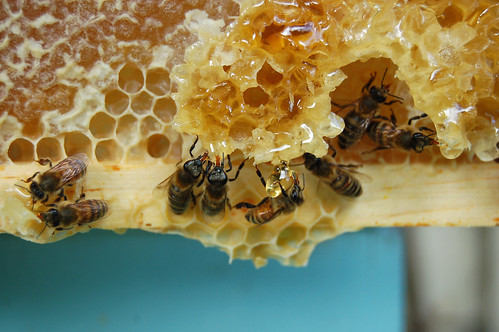
On Sunday, Robb and I opened up both of our hives, to see how things were going. We had split the Gloriana hive a few weeks back, and put a number of frames of brood and food in the spot where the old Elizabeth Taylor hive had been. Since then, both hives have been been foraging industriously, but Robb and I were curious to see how the bees' reproductive cycles were progressing.
Overall, things seems bustling. The bees busily lapped up the spilled honey where we inadvertently tore their comb. I love the one bee who looks like she's hugging a pillow made of honey. Who can resist the charms of bee tongues?

This frame went into the hive two days ago, and the bees have already built significant amounts of wax comb. They'll eventually knit all these paddles together into one seamless wall of honeycomb.
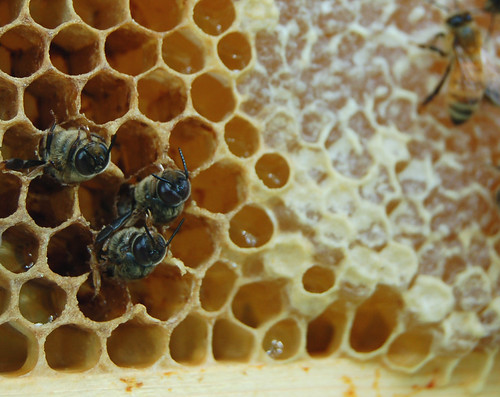
There were a few oddities, like the scattered dead drones, who looked to have starved just as they were emerging from their birthing cells. These dead bees also have their tongues sticking out, and in this case, one can observe the way the proboscis fans out into various parts. (Diagram here.) We could only speculate about what happened to these bees.
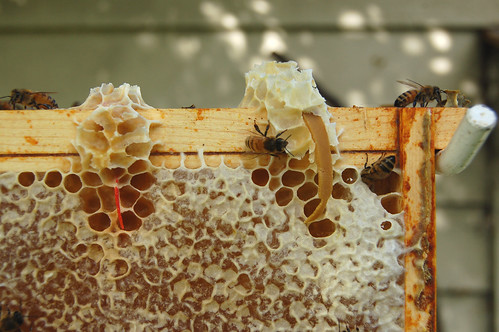
It took me a second to figure out what I was seeing when I pulled out this frame.
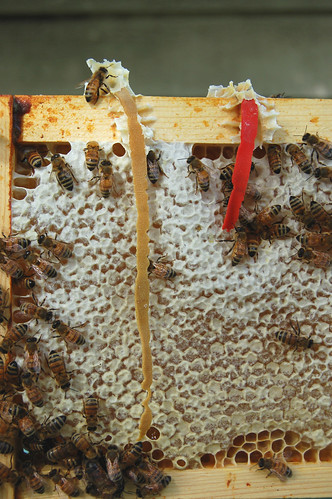
At some point, we must have inserted a hunk of loose honeycomb into the wooden frame, and secured it with rubber bands. The bees had incorporated the donated wax into their home, and you really couldn't see where one part began, and the other part ended.
I heard a delightful story at the bee event I went to this weekend, told by a beekeeper who saw one of her bees trying to fly away while grasping a secured length of rubber band. It must have looked like bee bungee jumping.
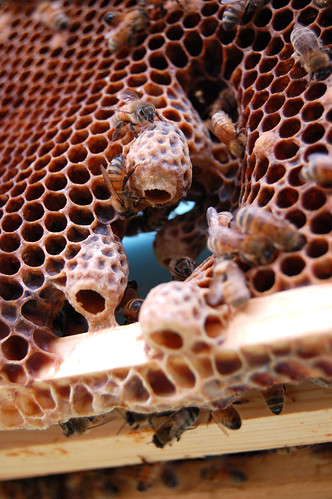
Our bees have always been very keen on building queen cups, which I'm told are insurance against a time when they might have to raise a new queen. The bees apparently have the ability to know when their queen is failing, and will raise a new generation of potential queens in these specialized cells.
What I can't recall is if I've heard that the bees are able to move eggs around the hive, and place them into these cells, or if I just dreamt that up. Does a fading queen know to lay in these cells?
The above structures were in place, when we looked in the hive a week ago.
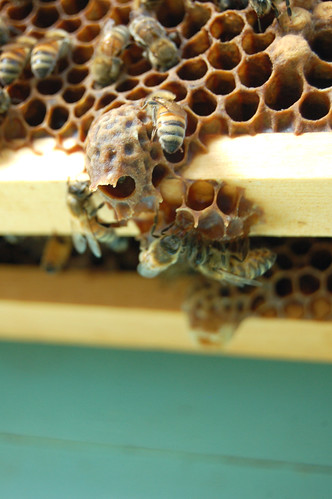
However, I don't recall seeing this cup.
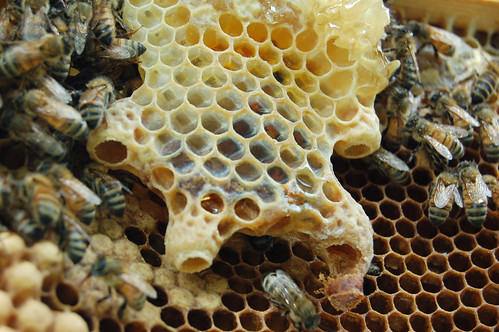
Or these. What's particularly interesting is the fact that some of these cups have been torn open on the side. The same beekeeper who told the rubber band story mentioned in passing that when newly hatched queens decide to kill their unborn rival-sisters, they rip open the sides of the cells. Queens, when they hatch out from their own cells, hatch from the bottoms. (See the differences between the ripped cell at 4 o'clock, and the opened one at 8 o'clock?)
Might the cups with the sort of flange/collar structures around their holes be cups out of which queens had hatched? I certainly don't know.
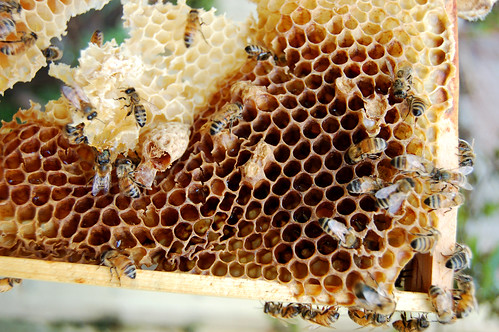
We saw ripped-open queen cells in the second hive, which we've named the QE2.
Does this mean that both hives had to raise new queens?
When we split the hives, we didn't try to find our queen. We knew she would be in one of the two colonies. And I -- mistakenly -- figured that it would be easy to see which hive got the queen by the observing which hive had new eggs, and which one had an interruption in the brood cycle.
As it turns out, neither colony had any eggs at all. There was capped brood, which was probably laid by the old queen in the Gloriana hive. But where did she go? Robb has been at home, sick for a couple of weeks, and has spent a good deal of time out in the garden every day. There's no way that our hive could have swarmed without him noticing.
So, did the queen die? Or did the bees have an abdication? We have no idea. Both hives are behaving normally, so we're choosing not to worry. We're going to stay out of the hives for a couple of weeks, to let the (fingers crossed) new queens start laying. I'm told that this is a delicate time in the life of a hive, and butting out is the best course of action.

One benefit of having an interruption in egg-laying is that any break in the reproductive cycle of the bees necessarily creates a disruption in the reproduction of the parasitic varroa mites. Our bees do have a varroa infestation, so perhaps this will lower the population of these destructive mites.
It's all very baffling. The longer I keep bees, the more I realize how much there is to learn. Robb reminds me that we didn't get all the way to the bottom of the hive boxes in the Gloriana hive. Those bees were getting too pissed off, so we left off before inspecting every single frame.
(If any beekeepers are reading this, I sure would like to hear your thought on what's going on in here. We looked and looked for queen bees, but found none. This isn't really surprising, because I stink at finding my own queens.)

On Sunday, Robb and I opened up both of our hives, to see how things were going. We had split the Gloriana hive a few weeks back, and put a number of frames of brood and food in the spot where the old Elizabeth Taylor hive had been. Since then, both hives have been been foraging industriously, but Robb and I were curious to see how the bees' reproductive cycles were progressing.
Overall, things seems bustling. The bees busily lapped up the spilled honey where we inadvertently tore their comb. I love the one bee who looks like she's hugging a pillow made of honey. Who can resist the charms of bee tongues?

This frame went into the hive two days ago, and the bees have already built significant amounts of wax comb. They'll eventually knit all these paddles together into one seamless wall of honeycomb.

There were a few oddities, like the scattered dead drones, who looked to have starved just as they were emerging from their birthing cells. These dead bees also have their tongues sticking out, and in this case, one can observe the way the proboscis fans out into various parts. (Diagram here.) We could only speculate about what happened to these bees.

It took me a second to figure out what I was seeing when I pulled out this frame.

At some point, we must have inserted a hunk of loose honeycomb into the wooden frame, and secured it with rubber bands. The bees had incorporated the donated wax into their home, and you really couldn't see where one part began, and the other part ended.
I heard a delightful story at the bee event I went to this weekend, told by a beekeeper who saw one of her bees trying to fly away while grasping a secured length of rubber band. It must have looked like bee bungee jumping.

Our bees have always been very keen on building queen cups, which I'm told are insurance against a time when they might have to raise a new queen. The bees apparently have the ability to know when their queen is failing, and will raise a new generation of potential queens in these specialized cells.
What I can't recall is if I've heard that the bees are able to move eggs around the hive, and place them into these cells, or if I just dreamt that up. Does a fading queen know to lay in these cells?
The above structures were in place, when we looked in the hive a week ago.

However, I don't recall seeing this cup.

Or these. What's particularly interesting is the fact that some of these cups have been torn open on the side. The same beekeeper who told the rubber band story mentioned in passing that when newly hatched queens decide to kill their unborn rival-sisters, they rip open the sides of the cells. Queens, when they hatch out from their own cells, hatch from the bottoms. (See the differences between the ripped cell at 4 o'clock, and the opened one at 8 o'clock?)
Might the cups with the sort of flange/collar structures around their holes be cups out of which queens had hatched? I certainly don't know.

We saw ripped-open queen cells in the second hive, which we've named the QE2.
Does this mean that both hives had to raise new queens?
When we split the hives, we didn't try to find our queen. We knew she would be in one of the two colonies. And I -- mistakenly -- figured that it would be easy to see which hive got the queen by the observing which hive had new eggs, and which one had an interruption in the brood cycle.
As it turns out, neither colony had any eggs at all. There was capped brood, which was probably laid by the old queen in the Gloriana hive. But where did she go? Robb has been at home, sick for a couple of weeks, and has spent a good deal of time out in the garden every day. There's no way that our hive could have swarmed without him noticing.
So, did the queen die? Or did the bees have an abdication? We have no idea. Both hives are behaving normally, so we're choosing not to worry. We're going to stay out of the hives for a couple of weeks, to let the (fingers crossed) new queens start laying. I'm told that this is a delicate time in the life of a hive, and butting out is the best course of action.

One benefit of having an interruption in egg-laying is that any break in the reproductive cycle of the bees necessarily creates a disruption in the reproduction of the parasitic varroa mites. Our bees do have a varroa infestation, so perhaps this will lower the population of these destructive mites.
It's all very baffling. The longer I keep bees, the more I realize how much there is to learn. Robb reminds me that we didn't get all the way to the bottom of the hive boxes in the Gloriana hive. Those bees were getting too pissed off, so we left off before inspecting every single frame.
(If any beekeepers are reading this, I sure would like to hear your thought on what's going on in here. We looked and looked for queen bees, but found none. This isn't really surprising, because I stink at finding my own queens.)

Comments
Queen cells near the lower part of the frame usually are swarm cells, those near the top of a frame are for supercedure.
BTW: I am now following your blog regularly and enjoying it.
Young queens will mate and return, but they won't take 10,000 of her best pals along for the bee-nookie.
Thanks.
I am enjoying reading your posts and the comments.
Grant